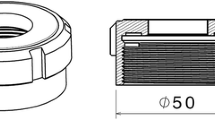Abstract
In order to obtain the desired mechanical properties of connecting bar after quenching and tempering, and reduce the cracking tendency and distortion, a program of controllable quenching was established. Furthermore, a computer-aided quenching (CAQ) system was developed. The applications show satisfactory results.
Similar content being viewed by others
References
Han Sw, Kang S H, Totten G E. Immersion time quenching [J]. Advance Materials and Processing, 1995, 8: 42AA–42DD.
Filetin T, Liscic B, Galinec J. New computer-aided method for steel selection based on hardenability [J]. Heat Treatment of Metals, 1996, 3(1): 63–66.
Cheng He-ming, Fan Jiang, Wang Hong-gang. Estimation of the mechanical properties of a 42CrMo4 steel cylinder with phase transformation during quenching [J]. Journal of Materials Processing Technology, 1997, 63(1–3): 568–572.
Reti T, Fried Z, Felde I. Computer simulation of steel quenching process using a multi-phase transformation model [J]. Computational Materials Science, 2001, 22(3–4): 261–278.
Smoljan B. Prediction of mechanical properties and microstructure distribution of quenched and tempered steel shaft [J]. Journal of Materials Processing Technology, 2006, 175(1–3): 393–397.
Yazdi A Z, Sajjadi S A, Zebarjad S M, et al. Prediction of hardness at different points of Jominy specimen using quench factor analysis method [J]. Journal of Materials Processing Technology, 2008, 199(1–3): 124–129.
Chen Nai-lu, Liao Bo, Pan Jian-sheng, et al. Improvement of the flow rate distribution in quench tank by measurement and computer simulation [J]. Materials Letters, 2006, 60(13–14): 1659–1664.
Chen Nai-lu, Li Qiang, Liao Bo, et al. Flow rate measurement and computational fluid dynamic of quench tank [J]. Transactions of Materials and Heat Treatment, 2002, 23(1): 33–36 (in Chinese).
Chen Nai-lu, Liao Bo, Pan Jian-sheng. Estimating quench severity of quenching oil at various flow rates with cooling curves [J]. Heat Treatment of Metals, 2002, 27(1): 46–48 (in Chinese).
Ye Ke-ming. Gear handbook [M]. Beijing: China Machine Press, 2000 (in Chinese).
Author information
Authors and Affiliations
Corresponding author
Rights and permissions
About this article
Cite this article
Zuo, Xw., Zhou, S., Chen, Nl. et al. Application of the computer-aided quenching technology on the connecting bar of 42CrMo4. J. Shanghai Jiaotong Univ. (Sci.) 15, 596–599 (2010). https://doi.org/10.1007/s12204-010-1053-8
Received:
Published:
Issue Date:
DOI: https://doi.org/10.1007/s12204-010-1053-8




